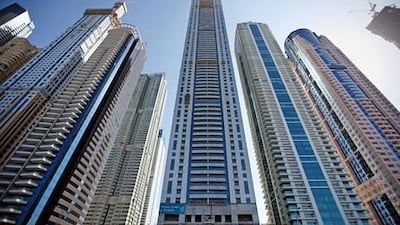DUBAI // At slightly more than 413 metres high, the Princess Tower in Dubai Marina is the tallest residential tower in the world.
But that was not always the plan.
"The original idea was to have an iconic tower in one of the best locations in Dubai, and to take advantage of the view," said Federico Tauber, the president of Tameer, the property developer.
At first, breaking a world record was not on the agenda of the ambitious team. Rather, they decided to construct a tower that would efficiently use the space allotted. The idea was formed in 2004 and in 2006, construction began.
"At that time the plot was very expensive, and from a developer point of view we had to maximise the use of that land," Mr Tauber said. "Nobody really new how tall it was going to be, but we worked to make it as tall as possible."
And so using a land area of 3,475 square metres, the team built a tower 413.4 metres high with a total build-up of nearly 167,225 square metres. The top floor of the tower offers a beautiful panorama of Dubai.
"A building like this is not built conventionally," said John Zwets, chief development officer. "The height and size of the building required some innovation with respect to timing."
According to Guinness World Records, construction of the tower is estimated to have cost US$210 million (Dh771.3m).
The building is constructed as if it were four buildings, one on top of the other.
This was done, Mr Zwets said, for the efficient distribution of power and water.
"One can imagine if we were to pump water 400 metres up the building the pressure involved would be of an industrial level," he said. "Rather than engineering it for that, what really happens is that every 25th or every 28th floor, there is a water transfer station."
A separate floor is taken out of residential use and is dedicated as a services floor, Mr Zwets said. This level contains a large water tank, a power distribution network, water pumps, heat exchangers and air handling units.
In addition to the building's design, its developers had to worry about logistics - primarily the safety and mobility of workers and the equipment. At peak production, 2,500 workers were on the job.
"The transportation of people from their camps to the site, moving them up the building in a safe manner - it's like managing the relocation of a small town every morning and every evening," Mr Zwets said.
Worker safety was monitored throughout the process. Lifts were always available as an escape mechanism, all fire escape staircases were built simultaneously and kept free, and independent hoists were located on the outside skin of the building in case of a calamity inside.
With 100 floors above ground containing 763 residential units and 16 penthouses, developers also had to consider the safety of their residents.
To do this, they improvised the design of the balconies.
"The balustrades have been designed to a height so that people cannot stand on the ledge or they cannot stand at a balustrade and somehow fall," Mr Zwets said.
On higher floors with larger balconies, engineers installed a wind detection system. The system detects the wind speed, and if it's beyond a certain limit, the sliding doors of that floor's units will not open.
"If the wind picks up beyond a certain speed, access to your own balcony is restricted," Mr Zwets said. "So if you want to go outside on a very windy day, it's not going to happen."
The name Princess Tower was given to represent the building's luxurious design.
However, the name called for another design element - a crown, which doubles as the shell that hides the four cooling towers that sit on top of the building.
In May, the tower was officially recognised as the tallest residential tower by Guinness, beating 23 Marina, its predecessor, which is also located in Dubai and which stands 392.8 metres tall.
Once Mr Zwets discovered that his team was approaching a world record, there was no turning back.
"We went forward with the tower really because we could," he said. "It was that simple."
mismail@thenational.ae

Dubai tower became world's tallest residential building by accident
The Princess Tower apartment block in Dubai holds the Guinness record for world's tallest residential tower and rises 413.4 metres above Dubai Marina.
Most popular today
